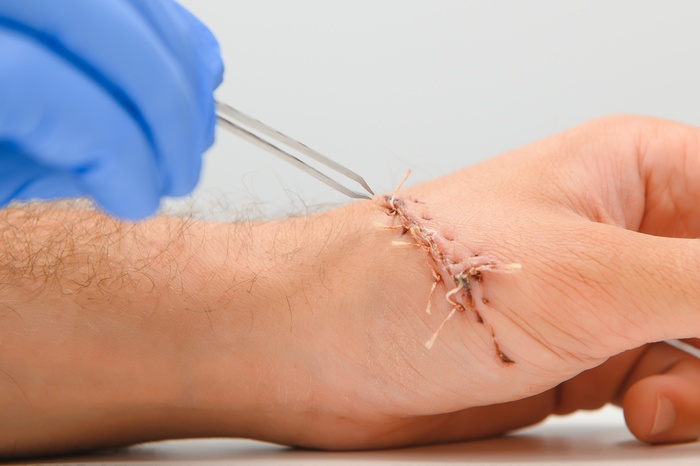
Feel better faster. Get care today.
From the clinic or your couch. Find high quality, same-day urgent care for you and your kids. Book an urgent care visit today.

While stitches are essential for proper wound healing, they can sometimes become a breeding ground for bacteria — resulting in complications that may hinder recovery. Recognizing the symptoms of an infected stitch is crucial for timely intervention, as untreated infections can worsen and lead to more serious health issues.
Recognizing the signs of infection after receiving stitches is vital for ensuring proper healing and preventing complications. Infected stitches can manifest through various symptoms that indicate the body's response to bacteria.
If you notice any of the following signs, the NIH explains that it’s important to consult a healthcare professional promptly:
Redness around the stitched area
Increased pain in the surrounding tissue
Swelling around the stitches
Yellow or green drainage coming from the wound
A bad smell emanating from the site
Fever or chills, indicating a systemic response to infection
Being aware of these symptoms can help you take swift action and avoid more serious health issues.

From the clinic or your couch. Find high quality, same-day urgent care for you and your kids. Book an urgent care visit today.
When the skin is cut or broken, it creates a perfect opportunity for bacteria, fungi, or viruses to enter the body. These germs can be present on the skin's surface, in the environment, or even in the instruments used during the stitching process.
Bacteria are the most common culprits behind stitch infections, with Staphylococcus aureus and Streptococcus being two prevalent types according to the NIH. These microorganisms can thrive in warm, moist environments, making wounds an ideal breeding ground if proper care is not taken. Additionally, factors such as poor hygiene, existing medical conditions like diabetes, or compromised immune systems can increase the risk of infection. Fungi can also contribute to infections, particularly in individuals with weakened immune responses or those who have undergone extensive surgical procedures.
According to the NIH, certain conditions and lifestyle choices can significantly increase the likelihood of developing an infection following a surgical procedure or injury. Understanding these risk factors, individuals can take necessary precautions to reduce their risk and promote optimal healing:
The wound wasn’t adequately cleaned before stitching
Weakened immune system due to illness or medication
Being overweight, which can affect circulation
Smoking, which impairs blood flow and healing
Diabetes, which can hinder the body’s ability to fight infections
Poor nutrition, which can affect overall health and recovery
Infected stitches can lead to serious complications if not addressed promptly. According to Medline Plus, these complications can escalate the severity of the infection and pose significant health risks, including:
Necrotizing Fasciitis: This is a severe, rapidly progressing infection that affects the soft tissues, including the fascia, which surrounds muscles and organs. It can result in tissue death and requires immediate medical intervention, often involving surgery to remove the affected tissue and aggressive antibiotic treatment.
Sepsis: This life-threatening condition occurs when the body’s response to an infection causes widespread inflammation, leading to organ dysfunction. Symptoms of sepsis can include fever, rapid heart rate, confusion, and difficulty breathing. It necessitates urgent medical care, often requiring hospitalization and intensive treatment to stabilize the patient.
Taking proactive measures to prevent infections can significantly reduce the risk of infection and promote optimal recovery. Here are some effective prevention tips from Mount Sinai to keep in mind:
Keeping stitches dry is crucial, especially in the initial days following the procedure. Moisture can create an environment conducive to bacterial growth, increasing the risk of infection. When showering or bathing, use waterproof coverings or avoid submerging the area until the stitches are removed or the doctor advises otherwise.
Maintaining cleanliness around the stitched area is vital for preventing infections. Gently clean the site with mild soap and water as directed by your healthcare provider. Avoid using harsh chemicals or scrubbing the area, as this can irritate the skin and compromise the healing process.
Avoid touching or picking at the stitches, as this can introduce bacteria from your hands to the wound. If you need to adjust a bandage or inspect the area, ensure your hands are thoroughly washed and sanitized beforehand. Limiting contact helps maintain a sterile environment and reduces the risk of infection.
According to Medline Plus, an untreated infection can spread through the bloodstream, potentially leading to systemic infections such as sepsis, which is a life-threatening condition. Additionally, the infection can extend to surrounding tissues, resulting in conditions like cellulitis or necrotizing fasciitis. These complications can require extensive medical treatment, including hospitalization or surgery. Therefore, recognizing the urgency of treating an infected wound with stitches is essential for safeguarding your health and facilitating a smoother recovery process. If you notice symptoms such as increased redness, swelling, pain, or drainage, seeking medical help without delay is the best course of action.
If you suspect that your stitches are infected, it is crucial to see a doctor as soon as possible.
While some redness and discomfort can be normal after receiving stitches, certain signs indicate that the infection may be worsening and requires immediate medical attention. Knowing when to see a doctor for infected stitches is crucial for preventing complications and ensuring proper healing.
Here are some warning signs that can help you take timely action to safeguard your health accoridg to Mount Sinai:
The wound reopens, exposing the underlying tissue and increasing the risk of infection.
you develop a fever, which can signal that the body is fighting an infection.
The wound is red and swollen, indicating inflammation that may be a sign of infection.
The pus increases in volume or changes color, suggesting a more serious infection.
The wound smells foul, which can indicate the presence of bacteria or necrotic tissue.
You experience increased pain or tenderness around the stitched area, signaling that the condition may be worsening.
If you notice any of these signs, the NIH notes that it is essential to consult a healthcare professional promptly to receive appropriate care and treatment.
Find and book same-day appointments for top-rated urgent cares, lab tests and telemed. Download the Solv app today! Convenient care, simplified with Solv.
Symptoms of infected stitches include redness around the stitched area, increased pain in the surrounding tissue, swelling around the stitches, yellow or green drainage coming from the wound, a bad smell emanating from the site, and fever or chills.
Infections in stitches and wounds are usually caused by bacteria, fungi, or viruses that enter the body through the cut or broken skin. These germs can be present on the skin's surface, in the environment, or even in the instruments used during the stitching process. Bacteria are the most common culprits, with Staphylococcus aureus and Streptococcus being two prevalent types.
Risk factors for infected stitches and wounds include the wound not being adequately cleaned before stitching, having a weakened immune system due to illness or medication, being overweight, smoking, having diabetes, and poor nutrition.
If not addressed promptly, infected stitches can lead to serious complications such as Necrotizing Fasciitis, a severe, rapidly progressing infection that affects the soft tissues, and Sepsis, a life-threatening condition that occurs when the body’s response to an infection causes widespread inflammation, leading to organ dysfunction.
To prevent infections after getting stitches, it is recommended to avoid getting the stitches wet, keep the stitches clean, and avoid touching the stitches. Keeping stitches dry is crucial, especially in the initial days following the procedure. Maintaining cleanliness around the stitched area is vital for preventing infections. Avoid touching or picking at the stitches, as this can introduce bacteria from your hands to the wound.